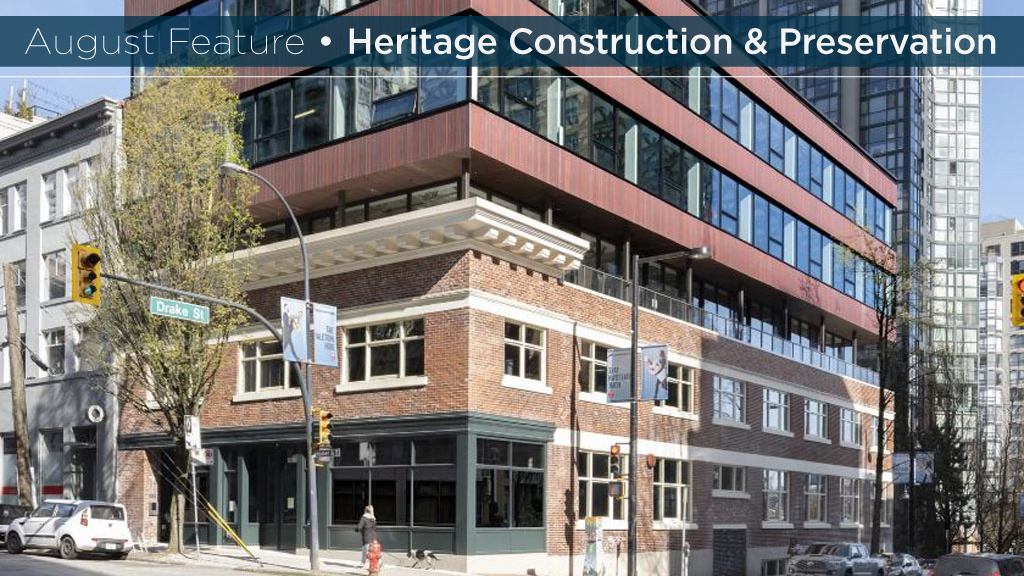Built in 1908 at the corner of Homer and Drake in Vancouver’s Yaletown district, the MacPherson and Teetzel Company Building contained warehousing and manufacturing businesses for much of the 20th century.
Work was recently finished on a four-year project to bring the structure up to date, which has also been known as Yaletown Square.
The project involved the rehabilitation of the two-storey building and the addition of a three-storey contemporary structure above.
The redevelopment created shell commercial space in the lower heavy-timber portion, and shell office space in the steel and glass addition.
Heritage interventions included preservation of the original exterior masonry walls and wood windows, restoration of the store front and cornice, and seismic upgrading of the historic heavy timber structure.
Derek Fleming, the project lead and associate principal at Acton Ostry Architects Inc., which was the architect on the project, said that in the late 1970s the building “underwent renovations unsympathetic to the historic building that saw the removal of many significant character-defining elements.
“The changes were made without any apparent thought to the heritage nature of the building,” said Fleming. “The original storefront and the overhanging cornice were removed. In addition, an exterior breezeway was cut into the building on Homer, an atrium was carved out in the middle, and a sunken entrance was created.”
The project was a mixture of rehabilitation and retention, said Fleming.
“Because Yaletown Square wasn’t legally protected, the owner could have torn the building down and built a new one on the same site and avoided all the challenges connected with preserving and rehabilitating it,” he said. “But he thought the building had character and wanted to keep it.”
Fleming said Yaletown Square was “a fun project, very interesting, with lots of unique challenges with project-specific problems to solve.
“Nothing about it was straightforward,” he said. “There was limited information about the building, just one or two old photos. And it took longer to complete the project than we projected, because COVID-19 caused some delays in construction.”
Fleming said that in addition to Yaletown Square, Acton Ostry has worked on other heritage projects in Vancouver, such as the Salt Building, located on the south shore of False Creek, the Alhambra Building and the Flack Block.
The latter two buildings are located in Gastown, one of Canada’s first heritage districts and a short walk from Yaletown.
Gastown was developed at the end of the 19th century and Yaletown a little later, at the beginning of the 20th century.
Gastown was close to Burrard Inlet and the western terminus of the Canadian Pacific Railway, and Yaletown was adjacent to False Creek and more CPR tracks.
For many years both were busy commercial districts humming with the activity of warehouses and factories.
Vancouver civic historian John Atkin said the warehousing and manufacturing businesses started to leave Yaletown in the late 1970s.
“The change in transportation and shipping had an impact on trucks making deliveries in the city, especially with the move to containers,” said Atkin. “And Yaletown’s streets were not built to handle large semi-trailers.”
In addition, many of the industries located in and around Yaletown were subject to changing business models.
“The paper companies that used to be on False Creek were swallowed up by larger conglomerates,” said Atkin. “They moved to purpose-built business parks in the suburbs.”
At about the same time as the warehouses and factories in Yaletown were closing, other businesses were moving in to replace them.
“The Vancouver School of Art had its graphic design and film studios on Smithe Street,” said Atkin. “Artists and others were taking over the warehouse space, so that an informal community was developing around the remaining businesses.”
In the 1980s, the provincial government bought the CPR rail yards, which became the site of BC Place, and later Expo 86, an international exposition of transportation and communications. The World’s Fair of 1986.
Yaletown’s existing building stock has been redeveloped and adapted to provide both residential and business units.
“Yaletown is a successful reinvention of a district that manages to retain and adapt heritage buildings that leaves the sense of the industrial past intact while accommodating new uses and in some cases new construction,” said Atkin. “I think this shows how a heritage district can continue to evolve and not be encased in amber.”
Anyone who is interested in finding out more about the rehabilitation of Yaletown Square can attend a “heritage lunch and learn” presentation by Fleming.
The online presentation takes place Sept. 14, from 12 to 1 p.m.
For more information click here.




Recent Comments
comments for this post are closed